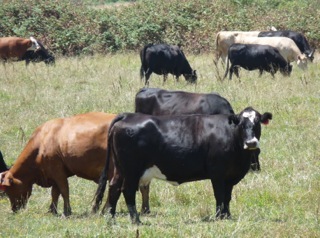Data Loggers Could Impact Cattle Comfort
Data Loggers Could be Hardship on Cattle Being Transported
By Patrick Cavanaugh, Farm News Director
Transporting cattle, or any livestock for that matter, has special nuances so drivers can get to the destination quickly for the animals’ comfort. Occasionally a driver can self-adjust the drive time beyond the mandated limit.
But now a new regulation regarding electronic logging devices by the Federal Motor Carrier Safety Administration in Washington D.C., may be implemented December this year, forcing drivers to stop.
“It would essentially require commercial truck drivers to use a electronic device to comply with the hours of service schedule that they’re required to meet, which limits both on-duty time and driving time,” said Justin Oldfield, a California cattleman and vice president of governmental affairs with the California Cattlemen’s Association in Sacramento.
“We not only have the cattle’s welfare that we need to take into account for, but we’ve got to get to that destination and make sure those cattle are off-loaded properly and safely,” Oldfield said.
Oldfield said they’re looking at some alternatives that would help the California Cattlemen’s Association members. “One of the things that we are concerned about is our distance to a lot of buyers, which would be in the Midwest,” Oldfield explained. “So any additional cost that this regulation might cause would probably be felt more significantly farther from the Midwest, which would primarily represent California, other states in the West and the Southeast.”
The current regulation is maximum on-duty time of 14 hours, with maximum driving time being 11 hours, with a 10-hour break. If a driver hauling cattle was only 100 miles from the destination, he would want to keep going for the comfort of the cattle. But with the electronic logger in place, he’d be forced to take that 10-hour break.
“Some of the issues that we have, for instance, is technically you’re on-duty even if you’re waiting to load cattle. So there are situations to where maybe there’s eight trucks waiting to load cattle, and you could be waiting in line for 2, 3 hours. And that entire time is counting against your on-duty time,” Oldfield said.
“We’re looking at where we can try to ensure that those hours are not counted against your maximum on-duty time,” he said.
And another area that’s being looked at is an exclusion for drivers hauling live animals, in order to have time to get to destinations.
“Our membership is basically past policy that asks us to look at everything, including that. There’s of course the challenge politically of making these changes on the regulatory side. I can tell you that nothing is off the table at this point,” Oldfield said. “Again, the reform is not necessarily the electron log-in device. The reform itself is the hours of service.”










